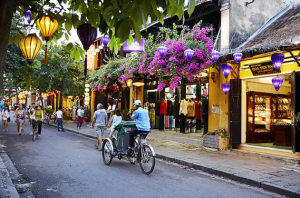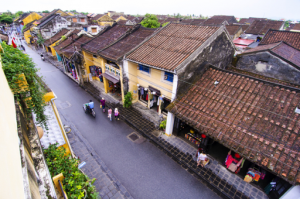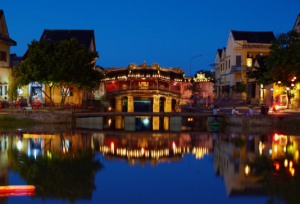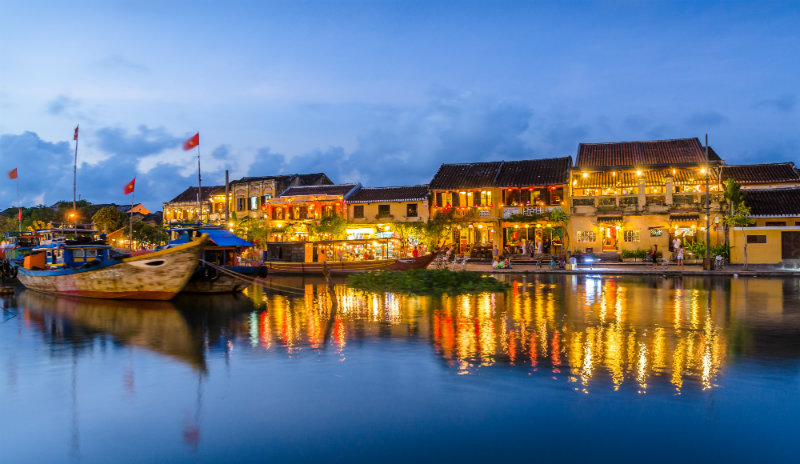Graceful, historic Hoi An is Vietnam’s most atmospheric and delightful town. Once a major port, it boasts the grand architecture and beguiling riverside setting that befits its heritage, and the 21st-century curses of traffic and pollution are almost entirely absent.

The face of the Old Town has preserved its incredible legacy of tottering Japanese merchant houses, Chinese temples and ancient tea warehouses – though, of course, residents and rice fields have been gradually replaced by tourist businesses. Lounge bars, boutique hotels, travel agents and a glut of tailor shops are very much part of the scene here.

Hoi An was my favorite destination in Vietnam. I loved spending time by the river, watching the sunset, strolling through the old town, and drinking inexpensive beer. The town is packed with picturesque historical homes, pagodas and street-side cafes. It’s extremely popular for buying hand-made clothing. You can get anything made here – from custom-made suits to gowns to sundresses to leather boots to sneakers. But even if you don’t want to shop, Hoi An makes for a relaxing destination, in an otherwise frenetic country. After all, a day at the beach is only a 15-minute bike-ride out of town. This was also my favorite place to gorge on Vietnamese food (don’t miss trying the cau lao that Hoi An is known for!).
By Unesco decree, more than 800 historic buildings in Hoi An have been preserved, so much of the Old Town looks as it did several centuries ago. Eighteen of these buildings are open to visitors and require an Old Town ticket for admission; the fee goes towards funding conservation work.
Each ticket allows you to visit five different heritage attractions from a total selection of 22 including museums, assembly halls, ancient houses and a traditional music show at the Handicraft Workshop. Tickets are valid for 10 days.
Technically, the tickets are for access into the Old Town itself, but you won’t normally be checked if you’re just dining or shopping in the area. Keep your ticket with you just in case. You could be checked for a ticket as you cross the Japanese Covered Bridge, but insisting that you are just visiting shops nearby usually works. When the bridge is very busy with pedestrians, chances are you won’t be asked either.
All four museums are small. Displays are pretty basic and the information provided minimal.
The Chinese who settled in Hoi An identified themselves according to their province of origin. Each community built its own assembly hall, known as “hội quán” in Vietnamese, for social gatherings, meetings and celebrations.
All the old houses, except Diep Dong Nguyen and Quan Thang, offer short guided tours. They are efficient, if a tad perfunctory. You’ll be whisked to a heavy wooden chair while your guide recites a scripted introduction to the house, and gives a souvenir soft sell. You’re free to wander around the house after the tour.
One downside to putting these old houses on show is that what were once living spaces now seem dead and museum-like, the family having sequestered itself away from visitors’ eyes. Huge tour groups can completely spoil the intimacy of the experience too, as they jostle for photo opportunities.
Despite the number of tourists who flood into Hoi An, it is still a conservative town. Visitors should dress modestly, especially since some of the old houses are still private homes.

Hoi An earned UNESCO recognition since as early as 1999
The town is not just reminiscent of the past, it truly takes one for a slow enlightening journey to the past. Such journey is simply unthinkable most elsewhere in Vietnam. It is only possible because of the careful and dedicated works that have gone into preserving and presenting its way – efforts that have come as the result of the UNESCO recognition. Enjoying the spotlight and catering to the increasing number of tourists flooding its narrow streets hoping to catch a glimpse of the past, hotels and resorts are now sprouting up all over town.




Phản hồi gần đây